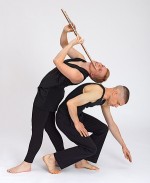Column Name
Title
“What is it in music, dance, or acting that carries you through time?” That is Zara Lawler’s burning question, and in pursuit of the answer, the Juilliard-trained flutist has been using her lifelong love of spectacle to create genre-bending performance pieces.
Body
“I’ve always been attracted by the mystery of how different art forms have so many incredible similarities and yet so many differences,” Lawler recently toldThe Journal. After participating in the Barnard-Columbia-Juilliard Exchange program, the Nyack, N.Y., native returned to Juilliard for her master’s, grabbing opportunities to play for the Composers and Choreographers course (a.k.a. ChoreoComp) as well as for campus operas, and ballets. Although she hadn’t yet focused on interdisciplinary performance while she was here (she received her master’s in 1994), she recalled that when her instrumental teachers used expressions such as “‘like a ballerina doing a pirouette,’” she thought, “What if I were the person doing the pirouette?”
After graduation, those thoughts started to take more concrete shape as Lawler was a freelance musician while starting to occasionally work with choreographers. And then, in 2000, she started working with Tales and Scales, an Evansville, Ind., ensemble that creates mini-operas for children performed by musicians and actors who move around the stage. Lawler remained with Tales and Scales for nine years, telling stories about “someone who has had some terrible experience gradually finding a way to re-engage with the world,” she said.
Lawler expanded on that theme of connectedness in Fantasies, a production she and choreographer/trombonist Neil Parsons, a fellow Tales and Scales alum, created to music by Telemann. In the final segment, Parsons crawls across the stage while carrying Lawler—and then she helps him back to his feet, exemplifying, she said, “the ultimate coming together of people and things that had been separate.”
These days, Lawler is working on creating more large-scale choreographic pieces that include many instrumentalists. In 2012, she created E Pluribus Flutum, a piece for up to 100 dancing flutists that was inspired by the Beijing Olympics, Busby Berkeley musicals, and flash mob dancing. The premiere took place last year in Central Park and included beginners, professional freelancers, adult amateurs, serious college students, and individuals from the Special Music School (a New York City public school).
And this fall, Lawler is tentatively scheduled to have a performance in New York City of her production of Salvatore Sciarrino’s 1997 work II cerchio tagliato dei suoni involving four solo flutists and 100 moving flutists, or migranti.
But flute and movement aren’t the only genres Lawler is crossing. Through Tales and Scales, she met marimbist Paul Fadoul and began pairing the flute and marimba a few years ago. “There’s something about the flute plus a slightly percussive and yet harmonically broad instrument that is very attractive,” she said of the unusual combination. “Audiences just go crazy for it.”
Lawler and Fadoul are working on a joint CD they hope to release before Christmas; it will feature commissions by composers Katherine Hoover and Roshanne Etezady as well as preludes and fugues for solo piano that Lawler and Fadoul have arranged for their instruments—and possibly some others.
While Lawler joked that she is “working on my grand unification theory of the arts,” her search for connection is serious—and sure to take many more intriguing turns.





